Source : business2community.com
By : Motoko Hunt
Category : Local SEO Search Orlando, Orlando Local Search Engine Optimization
I see that many Asian companies are shifting or thinking of shifting their digital marketing focus from search to social. Seems everyone likes a new shining object. We saw this trend in U.S. a couple of years ago. Is this a smart move? Most importantly, can social media replace search? Those companies that shifted their digital marketing focus from search to social a few years back are now actually bringing search back as the core tactic of their digital marketing. One of the reasons is that they didn’t see the performance they were hoping to get out of the social media campaigns.Forrester Research reported last year that less than 1 percent of online transactions among U.S. customers could be traced back to a social media post. According to Monetate’s study, online searches were the greatest contributor to e-commerce visits and sales, representing 31.43 percent of sales traffic. Email had 2.82 percent, and social media accounted for only 1.55 percent of all e-commerce traffic.
Econsultancy’s Social Data from last year showed:
About 50 percent of companies are using social data to gauge sentiment in order to have more targeted and relevant communication, to improve customer service, to address specific complaints, and to inform product and services development. Only 6 percent of participating companies said that social signals had a major impact on their search and social media strategies.“It’s not that social media failed those businesses, but they failed to understand the social in social media.” Scott Stratten of Unmarketing said that give-away campaigns (such as “Win an iPad”) only convert people who want a prize to follow brands’ twitter accounts or like their Facebook pages. They are not real fans of the brand or products, and won’t engage. Another trend in Asia is to put Paid Ads (PPC) as the main focus of the search engine marketing, and not putting much effort into SEO (search engine optimization). Is it because SEO is getting too hard? If you have a healthy and well optimized website, you should be getting at least half of your website traffic from organic search results. According to new research from GroupM U.K. and Nielsen based on 1.4 billion searches done in U.K., 94 percent of Google and Bing search users clicked on organic results compared to only 6 percent clicked on Paid ads. Do you really want to let go of that much potential traffic, and miss out on the business opportunities by only focusing on PPC? The fact is that SEO, paid ads, and social have different roles in the digital marketing ecosystem, and you shouldn’t be choosing one over another but try to make them collaborate. Consider the following 6 steps to deploy and manage your Search and Social projects that bring you closer to the business goals.
1. Understand your audience behaviors in search vs. social media
First, you need to understand how people behave both on social media and search engines. Review data such as when they use each and what they do or look for in search vs. social media. Even the search functions, social media search isn’t replacing search engines. You’ll be surprised at the similarities and differences if you compare the queries people use on search and social media. Look at your own data, and understand your audience.
2. Set your search goals and social media goals
Once you have a good grasp of your audience behaviors on search and social media, think about the roles of search and social media and align them to your digital marketing projects, and what you can and should achieve from search projects and from social media projects.
3. Leverage the social impacts on SEO
Especially with Google, we now see more impact from social media on the organic search results, i.e., social sharing, reviews, authorship, etc. Your digital marketing strategy should leverage the social activities and social assets to improve the organic search performance.
4. Integrate search and social
As long as you think of search and social media as separate projects and place them in silos, you won’t see the maximum impact for your business. Create a cross-functional process between the search and social so that you can integrate the search learning into social media, and the social media learning into search. The search keywords, social conversations, and the target audience behaviors are some of the key information that you should be sharing between the two.
5. Set the best practice, then enforce it to make sure everyone follows it
Next, you want to put all the findings, goals, and process into a best practice guide for your digital marketing team. Provide the training so that everyone understands it, and enforce the guide among all concerned parties.
6. Establish the communication channels among SEO, Paid and Social
After you get to step 5, and everyone goes back to each team or department, it’s likely that no one would have time to check in with each other to share the information even if it’s in the best practice guide. Mandate to review each other’s reports, and have monthly or quarterly meetings to share the learning and the challenges.
Source : clickz.com/clickz/column/2304624/search-engine-marketing-vs-social-media-all-i-want-is-everything-so-should-you







